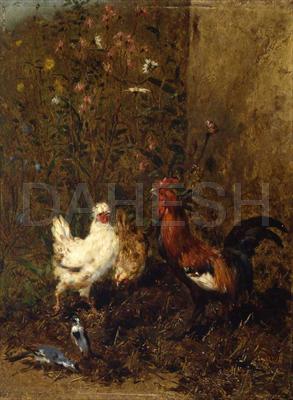Philibert-Léon Couturier (French, 1823–1901)
Chicken and Birds
Oil on canvas, 14 x 10 ½ in.
DM83

The regional artist Couturier was born in Burgundy, but lived most of his life in Saint-Quentin in northern France. He entered the École des Beaux-Arts in Paris in 1844 and trained under the history painter François-Édouard Picot. Couturier began exhibiting regularly at the Paris Salon from 1845, as well in regional exhibitions in France. Couturier was an animal painter who specialized in farmyard scenes – particularly those depicting chickens. Théophile Gautier dubbed Couturier “the King of the Chickens” and Edmond About referred to the artist as “the King of the Barnyard.” This type of specialization was typical of many mid-19th century artists, as the new middle-class patrons looked for relatable subjects painted on a smaller scale that would fit in their homes. As William Makepeace Thackeray described it in 1843, this was the era of the “bread-and-butter idyll” – or images that are easily relatable, as “bread and butter can be digested by the very many.”
Chicken and Birds depicts a rooster, two hens, and two smaller birds within an unspecified outdoor setting. Scenes of farm life had been created since the 17th century, but they became increasingly popular in the 19th century, when the growth of cities and industrialism generated nostalgia for rural life. The expansion of genre painting (or scenes of everyday life) at this time was also a response to the Realist movement of the mid-19th century, which emphasized a “truth to nature” over grandiose mythological or biblical scenes. Couturier was an admirer of the artists Jean-Baptiste-Camille Corot and Jean-François Millet (who created scenes of the local French landscape and peasants), and wrote studies about both artists in the 1870s. While the subject matter of Chicken and Birds is typical of Couturier’s oeuvre, the visible, loosely applied individual strokes differentiates it from many of his other farm scenes.


